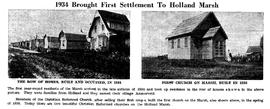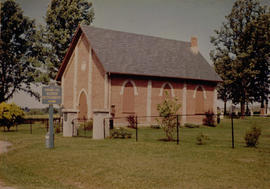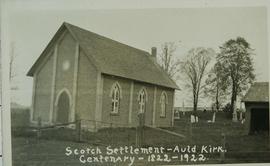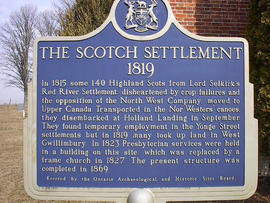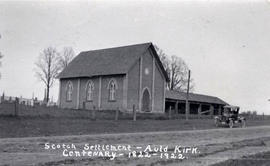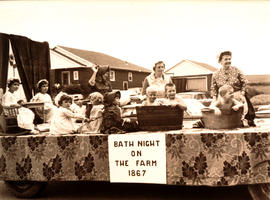The Auld Kirk Church is located on the south half of Lot 8 on Concession 6 of West Gwillimbury. In 1819, a group of Scottish and Irish settlers arrived in Upper Canada, and developed the area known today as the "Scotch Settlement". After the initial goal of building homes to fulfill the stipulation of the land grants, their thoughts turned toward building a church and school to educate their children. In 1822, land was obtained from John Faris, an Irish farmer, for a graveyard. In 1823, a log church was built on the land, and it also served as a school house during the winter months. This building, which was later moved to a different location, was the first school and church in Simcoe County. The congregation first met On January 6, 1822. James Sutherland, a settler, was authorized by the Church of Scotland to conduct baptisms and marriages until there was a settled minister. The first settled pastor was not until 1831. In 1832, they decided to send for a minister from the Established Church of Scotland, which resulted in a split in the congregation, and a new Church being formed in Bond Head. The remaining congregation stayed true to the belief's of the Church of Scotland, and the church never had an organ, and only Psalms were sang, not wrtten hymns. All of the sermons were long and in Gaelic, and were interpreted. In 1869, the present church was built costing $1000 to the congregation. Due to dwindling numbers, the church was closed in 1885. A new roof was put on in 1912, and in 1929, shutters were put on the church and the doors repaired. A fence was also put around the cemetery, and the driving shed was moved to a local farm where it still exists today. Another restoration of the church was done in 1958, when a new roof was put on, the windows were put back in, new steps were built, it was painted inside and out, and the floor was jacked up. Two plaques were dedicated in 1958. One was unveiled by Henry McKay in honour of his aunt and uncle, Mr. and Mrs. James McKay, some of the first settlers. The other was unveiled by Angus Campbell, for the Ontario Government's recognition of the Selkirk Settlers.

